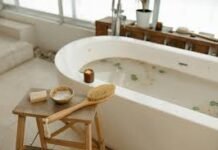Last Updated on March 21, 2024 by Nasir Hanif
Table of Contents
Quick Mold Removal
Mold loves moisture and may cause serious health problems. In homes and buildings, mold is unsightly and difficult to remove. A significant mold accumulation is an area of more than ten by ten feet, and if more extensive, consult a restoration professional. But, if you are up to it, here are some pointers.
Safety First:
Do not use any cleaning liquid unless it is made to clean mold. Use gloves, safety glasses, and a filtering mask. Local paint stores and hardware outlets have several products available that are ideal for removing mold. Read and follow the directions and never mix one solution with another. Also, never change cleaners in the same area as different chemicals may have unexpected bad reactions.
Do not use bleach or ammonia, and never mix them. Every year people are seriously injured, sometimes mortally. Stick to cleaning products meant to remove mold only, and never mix with other cleaners.
Ventilation –
Always have as much flowing air as possible in the work area. Cleaning chemicals can cause eye, skin, and lung irritation. Use fans to vent air out of the building and turn on any built-in fans. Mold spores can float and start new accumulations.
Scrub the Moldy Area:
Use a few tablespoons of dish soap in a bucket of warm water. Scrub the area and wipe dry with paper towels.
Apply the Mold Cleaning Solution:
Apply the solution as recommended by the manufacturer. Distributors want their product to work, so customers trust the brand.
Dry the Surface:
Mold can find a new home in 24-hours.
Quick mold removal is a preventative project and, if done correctly and safely; but know when to call a restoration professional. Anything more than a small surface accumulation could mean hidden mold. Water damage could mean hidden moisture.
Mold and Health
Mold, a type of fungus, is multicellular and, under close observation, seems furry. These filaments entangle and form a single organism. Molds reproduce by releasing visually undetectable spores, much like seeds, into the air to drift landing where they can grow. Mold spores are everywhere, and hopefully for the sake of human health in low concentrations. When mold starts to discolor surfaces, sensitive people may have allergic-type reactions, and others may have asymptomatic reactions not sensing the effects.
Health hazards exist when mold takes hold in homes or buildings. Spores in large numbers can cause allergic reactions and worse breathing problems. Certain molds produce toxins that, according to some research, may cause neurological difficulties, but more information is coming. The first concern is long-term indoor exposure. Humid and damp areas are an ideal condition for mold. It is worse with poor ventilation and humidity. Mold is commonly seen under sinks, bathrooms, or anywhere a plumbing leak occurs. Outside walls can grow molds. Visible mold may not be the whole story; mold can grow in crawl spaces and in walls.
Prevention First
Avoiding the problem is the first line of defense. Since moisture and lack of ventilation are the chief causes, keeping moisture low in damp areas is essential. The bathroom, at home and work, should have good ventilation. Especially after a shower, open the window or have the fan running. Ensure all sinks are correctly sealed to the counter so spills don’t seep below. Inspect under sinks and around windows and keep weather stripping in good condition at doors and windows.
Minor plumbing leaks can go unnoticed for weeks, even months, before noticeable. These leaks often occur in walls, ceilings, and below floors. Hidden leaks increase the chances of hidden mold. Check for mold around piping you can see. Listen for spray or dripping sounds; it needs attention without delay. Review water bills to see if there are any significant changes. Smell for “musty” scents that may indicate seepage. The best home test is probably to check the water meter before leaving home, or a business, for a few hours and check the meter when returning. Any change could be a leak.
If you get any indication of a leak, and it’s not apparent what the source is, it may be time for a professional. For example, pipes below a cracked foundation will let in moisture. If mold is already present, a mold removal service will use instruments to detect leaks before removing the mold. Often roofing in need of repair will have hard-to-find seepage.
Flooding and Water Damage
When the worse happens, clean-up is critical to assure mold has little chance to take hold. First, remove standing water, and then completely dry the area. With significant flooding and damage, contact a restoration professional – they have the technology to find hidden mold.
Tackle more minor problems as a home project. The local rental yards will have fans and HIPA filters made for the purpose. Once the area is dry, it is essential to clean all affected surfaces, and running a HIPA filter for an extended period will capture any mold spores settling in.
The number one concern is if moisture gets behind the walls, into rugs, and ceiling. Here again, professionals are the best assurance that the moisture was removed entirely. In any event, call a mold removal restoration technician to check for mold.
Bottom Line
In recent years, mold has come under greater scrutiny, and for good reason. More and more people are developing symptoms and tying them to the mold. Continuing research points to mold as a hazard. Mold is a hazard that causes allergic-type reactions and may cause medical problems. Mold exposure in the home, at work, or in commercial buildings is problematic. Remove mold as it is found, and it is a quickly done project, but a quick mold removal job may be incomplete. Hidden mold may continue to grow, undetected small water leaks will bring the mold back, and more damage can be very costly. A restoration professional solves the problem and prevents further damage – know when to call one.





















